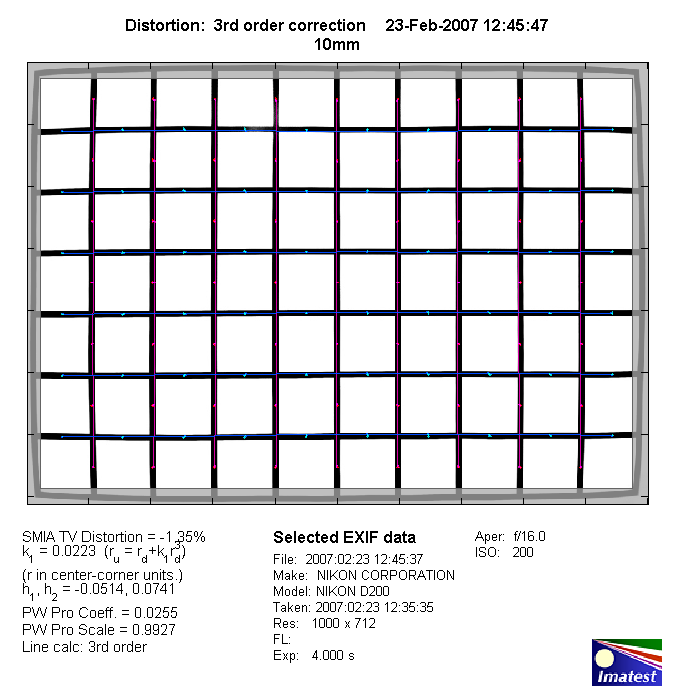|
Sigma AF 10-20mm f/4-5.6 EX DC HSM - Review / Lab Test Report - Analysis |
|
Lens Reviews -
Nikon / Nikkor (APS-C)
|
|
Page 2 of 2
Distortion
The Sigma AF 10-20mm DC showed a rather unusual distortion characteristic. At 10mm most of the
image field is almost free of distortion so the measured distortion figures look fairly fine here
(taken a little inward from the extreme borders). However, this is only part of the truth. If you check the
10mm distortion chart below you will notice that the extreme corners are actually heavily
(barrel-)distorted - probably in the 2-3% range. At 14mm the lens shows a moderate degree of
pincushion distortion, even less so at 20mm.
|
Move the mouse cursor over the focal length text marks below to observe the respective distortion
|
| 10mm |
14mm |
20mm |
|

|
The chart above has a real-world size of about 120x80cm.
Vignetting
Typical for many ultra-wide zooms, especially those with an APS-C image circle,
the Sigma also suffers from heavy vignetting problems which are most pronounced at
10mm @ f/4. At 14mm @ f/4.8 vignetting is not much better, a little less so at 20mm.
One stop down from the max. aperture helps to reduce the problem to an acceptable degree.
Ultra-wide lenses exhibit some "natural" vignetting so the issue doesn´t/cannot
disappear completely.

MTF (resolution)
The lens has been tested twice now with a clearly better 2nd sample (commented as follows).
The center performance is exceptionally high at all tested focal lengths and aperture settings.
At 10mm the border performance is easily on a very good level whereas the extreme corners show
some softness at f/4. However, they catch up nicely by f/5.6 (very good). The lens is able
to keep up the very good border performance at 14mm and 20mm. Quite impressive all-in-all.
I should mention that the Imatest analysis tool had quite some problems to generate reliable
test date at the "extreme borders" due to the combination of heavy distortion, CAs and field
curvature. The readings are therefore less accurate than usual.
Please note that the MTF results are not directly comparable across the different systems!
Below is a simplified summary of the formal findings. The chart shows line widths per picture height (LW/PH) which can be taken as a measure for sharpness.
If you want to know more about the MTF50 figures you may check out the corresponding Imatest Explanations
Chromatic Aberrations (CAs)
Lateral Chromatic aberrations (color shadows at harsh contrast transitions) are moderate for
an ultra-wide zoom lens. At 10mm the average CA pixel width exceeds 1 pixels at the borders which
is very decent relative to similar ultra-wide zoom lenses. However, it is also worth to
mention that the CAs are much worse in the "extreme corners" peaking beyond 2px here. At 14mm
and 20mm CAs are only a minor issue.

Verdict
The Sigma AF 10-20mm f/4-5.6 EX DC HSM showed a very good performance during the tests
especially in terms of resolution. There's some softness towards the extremes at 10mm @ f/4
but otherwise there's really nothing to complain here (within this specific lens class
anyway). The vignetting and distortions are quite comparable to the rest of the gang.
Lateral CAs are generally well controlled except in the extreme corners of the
image field. The Sigma offers a little extra kick regarding the widest setting (10mm vs 12mm of
the Nikkor or Tokina) so the quality is fairly impressive regarding the increased design
complexity here. The build quality is very good and the AF is both fast and virtually silent.
If you're looking for a candidate in this class the Sigma is worth a look but watch out
for sample variations.
|
|
Last Updated on Thursday, 12 August 2021 15:51 |